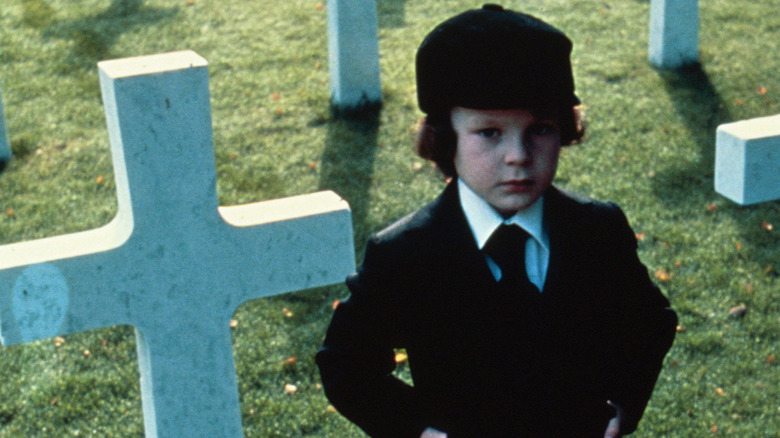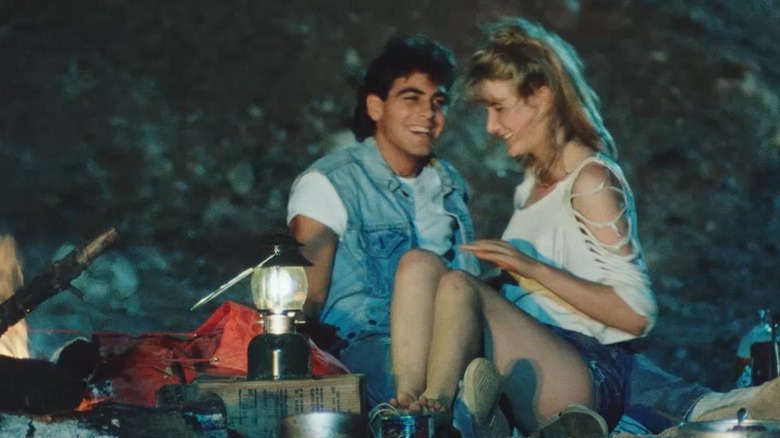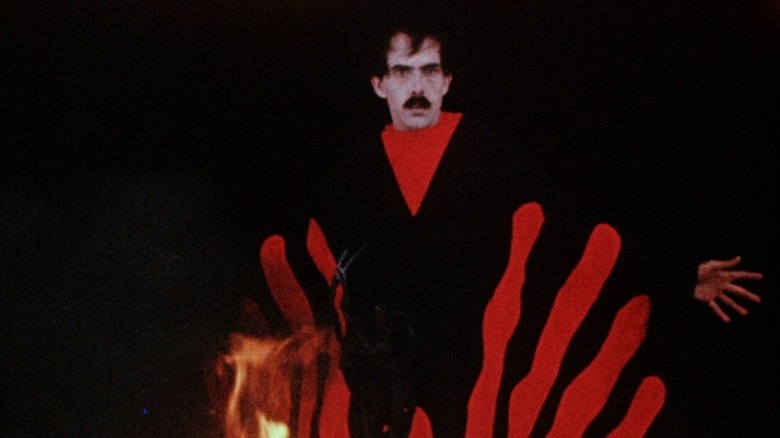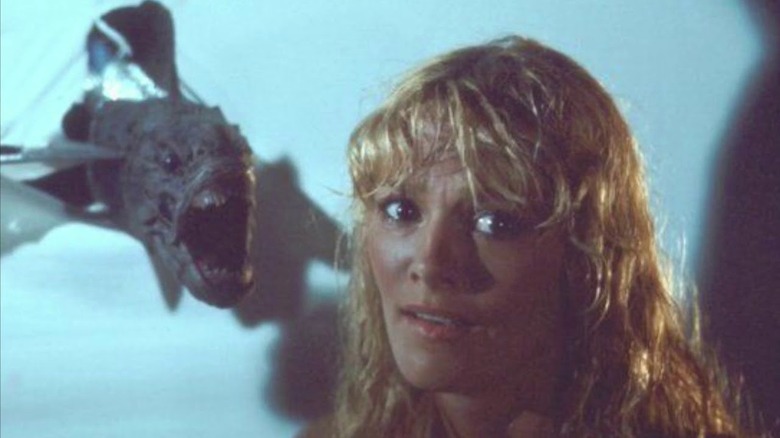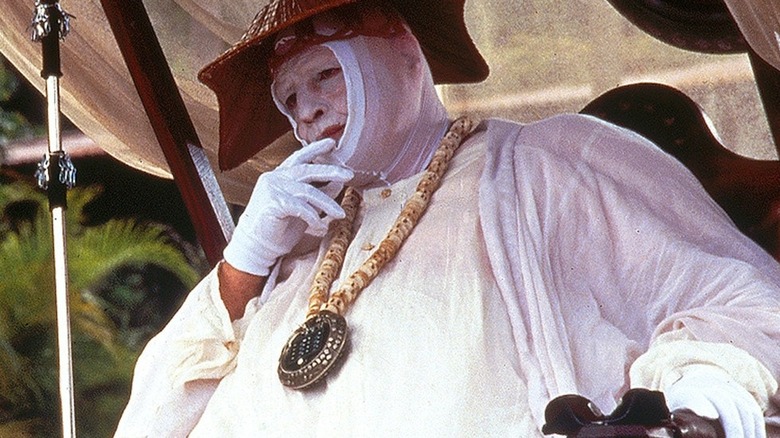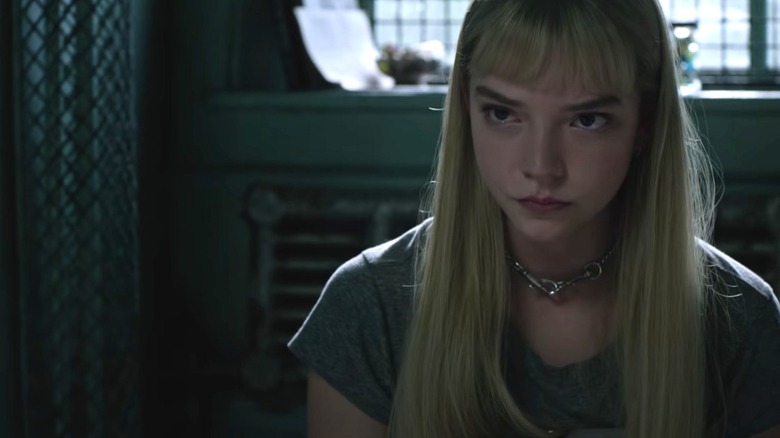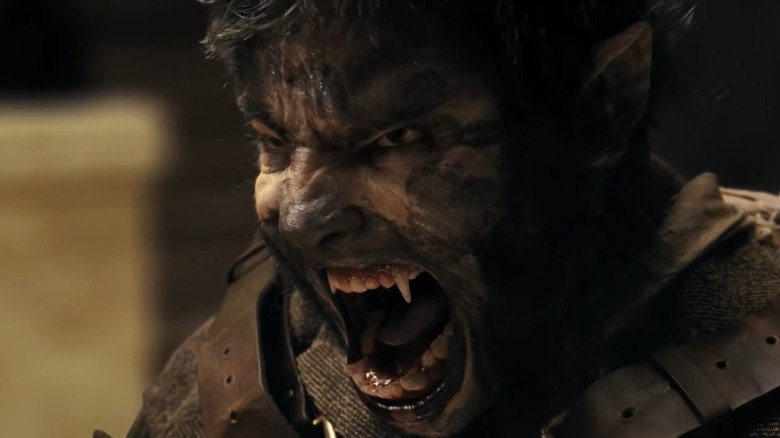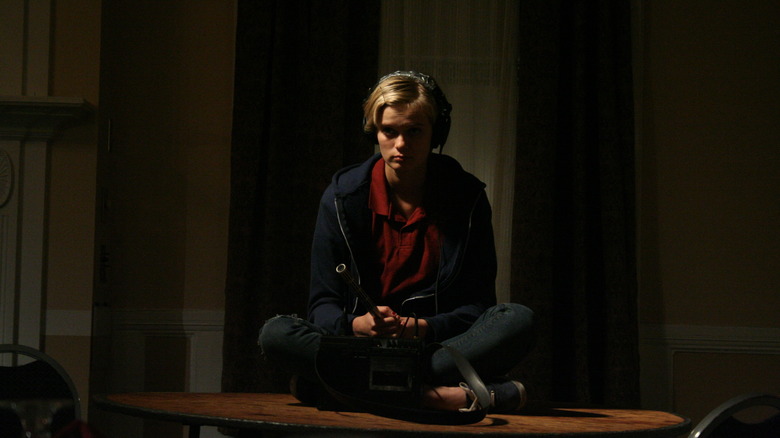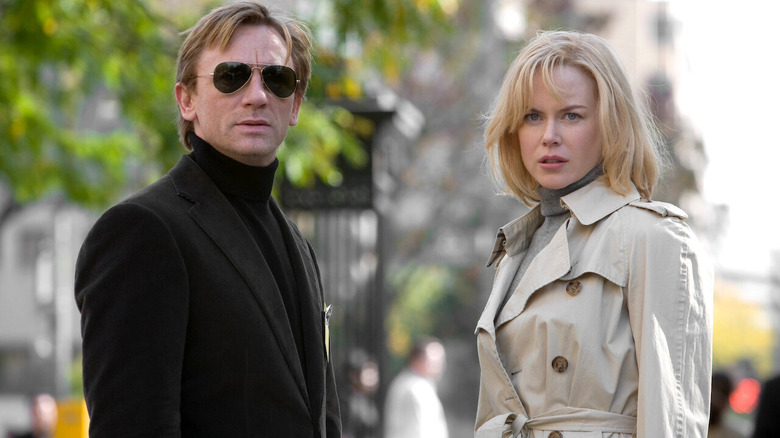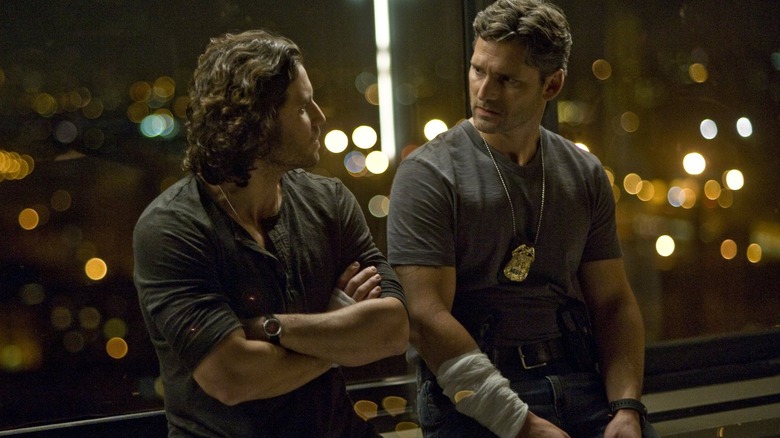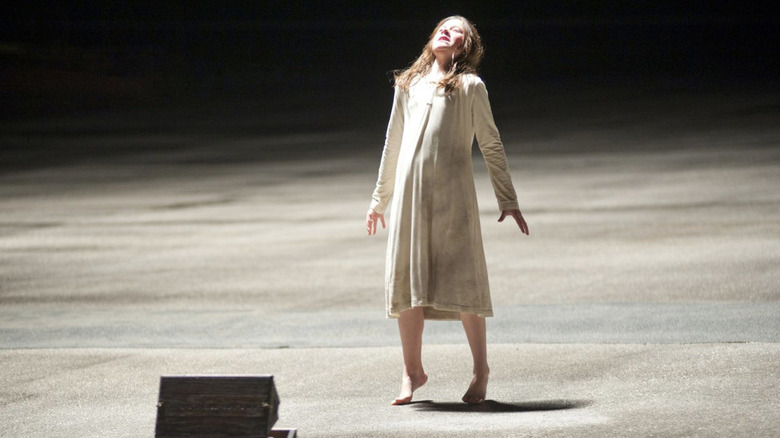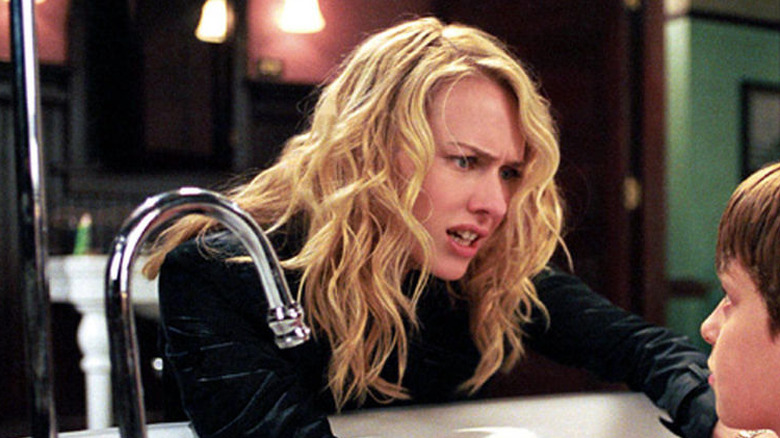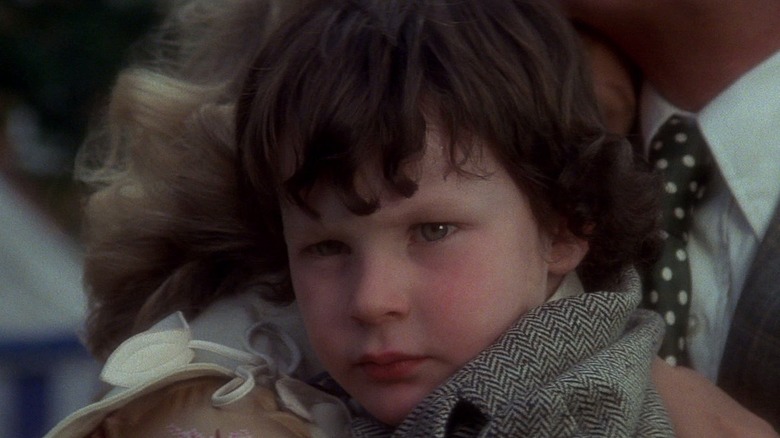Movies That Were More Terrifying To Make Than They Were To Watch
Every film is a challenge to make. Organizing enough people to turn a script into a fully-formed feature-length production is such a daunting undertaking that it's a wonder we have any movies at all. But some features are significantly harder to make than others.
This has been especially true of a variety of horror movies over the years that were plagued by a barrage of difficulties during production. Such motion pictures have often been even more spine-tingling in their behind-the-scenes turmoil than in any of the images that ended up projected on the silver screen. This is even true of iconic horror films like "The Omen," whose unforgettable fictional scares still can't measure up to the real-world horrors encountered while bringing it into being.
There's no one type of problem that these features encountered on their respective tortured roads to completion. Some were plagued by budgetary and filmmaking issues that helped drag production on for years. Others were tormented by more inexplicable phenomena like sudden fires, exploding lights, or other weird events that some attribute to paranormal sources. There's no shortage of bizarre events that turned principal photography on these horror films into a nightmare. If you thought the jump scares in these movies were frightening, just wait until you hear about the terrifying circumstances that befell the artists tasked with bringing their stories to life.
Grizzly II: Revenge
On the surface, "Grizzly II: Revenge" seems like a run-of-the-mill horror movie. Sequels are common in the domain of scary cinema, and "Jaws" had proven so successful in 1975 that it spawned a swarm of other movies about animals attacking, including ferocious bears. But "Grizzly II" was anything but a simple excursion thanks to a nightmare production that included trying to figure out how to realize the main bear antagonist on a limited budget, organizing a music festival in Cold War Hungary, and most notable of all, the desertion of the feature's primary financier. Oh, and the animatronic killer bears eventually went missing, sending the project into a tailspin.
With all these critical problems plaguing the production, "Grizzly II" was left in incomplete limbo for decades. An already grueling process became the worst-case scenario for any director as the years went by without even a hint of progress on the project. But in 2020, "Grizzly II" finally saw the light of day, decades after it was initially supposed to release and long after the original "Grizzly," which came out in 1976, had faded from mainstream memory. While the final film was a long way from being the next "Jaws," this was a case where reviews didn't really matter. The very existence of this movie after so much turmoil was a victory in and of itself.
Manos: The Hands of Fate
"Mystery Science Theater 3000" fans will immediately recognize the name "Manos: The Hands of Fate," an ill-advised attempt at a horror film that proved ineffective at providing scares, but inspired in delivering unintentional guffaws. With its stiff line deliveries, bizarre costume choices, and never-ending opening credits sequence, there are more inexplicable parts of "Manos" than there are stars in the night sky. The starkly unfrightening nature of the movie means that even the smoothest production would likely be scarier than "Manos." However, this low-budget indie had a truly tumultuous time getting finished, one that blows away the final product in terms of scares.
In an interview with the film's cinematographer, Robert Guidry, it was revealed that many of the hardships faced in filming this film came down to its director, fertilizer salesman Harold P. Warren, who also stars in "Manos." The filmmaker could only muster up $19,000 for the budget, which ensured, among other limitations, that Guidry could not get proper lighting for the film or redo subpar shots. It also meant that Guidry wasn't getting paid. Meanwhile, Warren's disagreeable behavior towards the crew included throwing a slate at Guidry and screaming at the women hired to portray the wives of The Master. The set was a nightmare to endure and provided the kind of harrowing experiences that were absent on-screen in the final cut of "Manos: The Hands of Fate."
Piranha II: The Spawning
Everyone has to start somewhere — even the king of the world. Director James Cameron would eventually be the filmmaker behind mega-budget blockbusters like "Titanic" and "Avatar," but his first feature-length directorial gig was helming the horror sequel "Piranha II: The Spawning." Or at least, he was supposed to be the one in charge.
In a testament to how much of a chaotic nightmare making "Piranha II" was, Cameron was apparently the director for only a couple of weeks. He'd initially been hired to supervise the film's special effects, but was abruptly promoted to director after the original director was fired by producer Ovidio G. Assonitis. After struggling to work with "Pirahna II's" non-English speaking crew, Cameron himself was fired by Assonitis, who took over the production himself. Officially, though, Cameron still got the director credit.
Upon seeing how badly the feature was coming together, Cameron, with no legal recourse to take his name off the project, opted to go rogue, reportedly breaking into the editing suite and attempting to put together his own cut of the project, which was later released on home video. It's the exact kind of behavior you'd expect from someone who ran such a tight and controlling ship in his later directorial efforts. While later Cameron features would be famous for how they influenced visual effects and pop culture at large, "Piranha II's" greatest legacy is the horror stories of how it got made.
The Island of Dr. Moreau
The sights on the titular location of "The Island of Dr. Moreau" are supposed to make your blood curdle and offer an ominous warning to man about meddling in God's domain. But if you were a moviegoer in the late 1990s, far more petrifying was the saga of how the H.G. Wells adaptation was realized. "The Island of Dr. Moreau" was a passion project for director Richard Stanley, but his refusal to attend production meetings and clashes with cast members, including nominal leading man Val Kilmer, meant he only oversaw the first three days of filming before being replaced by John Frankenheimer.
Any hopes that a new director could right this sinking ship were sadly mistaken, as "Dr. Moreau" only fell into greater chaos. Frankenheimer also had trouble with the hot-headed Kilmer, but Kilmer was nothing compared to Marlon Brando as the titular Dr. Moreau — Brando reportedly refused to learn his lines, came up with strange character ideas, and occasionally just couldn't be found. Let's also not forget that Stanley was later able to sneak back onto the set, get dressed up as a man/animal hybrid, and covertly participate as an extra in a key set piece of the final film (he wouldn't direct another feature until 2019's "Color Out of Space"). Who needs the ominous words of Wells when you've got an unforgettable filmmaking-gone-awry story like this one?
The New Mutants
A brand-new exciting corner of the "X-Men" film franchise was set to be explored in 2020's "The New Mutants." Audiences had already seen multiple Deadpool and Wolverine outings, but this would be the first time in the history of the franchise that the world of mutants would be filtered through a horror cinema gaze. With an emphasis on scares, not explosions, "The New Mutants" had a shot at being something special — at least on paper. Director Josh Boone oversaw the filming of the movie in 2017 for a projected April 13, 2018 release date cleverly (or perhaps foolishly) timed to coincide with Friday the 13th. Everything seemed to be lining up nicely ... until the post-production process began.
This was when the first of several release date delays occurred, with "The New Mutants" initially postponed to February 2019 to make room for lengthy reshoots that were reportedly meant to make the final cut even scarier. This worrisome but by no means fatal development quickly got worse and worse as the delays continued and the reshoots never actually happened (possibly due to the Disney/Fox merger). Even a planned April 2020 debut was derailed thanks to the COVID-19 pandemic, and the "X-Men" spin-off died a quick death in theaters in August 2020 instead.
Perhaps something weird was going on at the old mental hospital where the film shot — Boone told IGN that every crew member reported strange happenings on set, though the director himself remains skeptical.
The Wolfman
The 2010 take on "The Wolfman" wasn't supposed to be such a monster, but this R-rated horror interpretation of the classic Universal Monsters character was already off to a turbulent start when original director Mark Romanek left in pre-production. A mad scramble ensued to get a new director signed on so that the film could still come out in 2009 and reap the rewards of a buzzy cast that included Benicio del Toro, Anthony Hopkins, and Emily Blunt. By February 2008, Joe Johnston had signed on to helm the feature, which would begin filming just a few months later.
But things only got scarier once the cameras stopped rolling on the initial principal photography. Reshoots were eventually enacted that lasted for a whopping six months and drastically overhauled the piece. Perhaps most baffling of all in terms of the behind-the-scenes troubles here was the indecision over the film's score. Danny Elfman's original compositions for "The Wolfman" were discarded and the legendary musician was subsequently replaced by Paul Haslinger. But Haslinger's score didn't pass muster either, so Elfman's music, with new material by other composers, was brought back.
The tepid reviews for "The Wolfman" indicated people didn't find the final cut of this creature feature all that scary, but at least the movie provided unforgettable fright in its tortured production history.
The Innkeepers
For the horror film "The Innkeepers," which takes place in a haunted hotel, director Ti West was looking to shoot in a spot that would enhance the feature's spooky atmosphere. This is when he got the idea to return to a location he'd used in a prior film: the Yankee Pedlar Inn, a haunted hotel located in Torrington, Connecticut. This hot spot for supernatural devotees was a place West first encountered while making his 2009 film "The House of the Devil." Talking to The Morning Call, West noted that he'd experienced inexplicable events while staying at this location. "I'm a skeptic," he said. "Spending time at the Yankee Pedlar was the closest I've come to believing."
Years after "The Innkeepers" finished filming, lead actor Sara Paxton divulged to Dead Talk News that she'd had several weird experiences while filming the movie inside the hotel, including a TV inexplicably turning on in the middle of the night. She wasn't alone — Paxton noted that nearly everybody who worked on the movie inside the Yankee Pedlar had something strange and frightening happen to them. Ti West was playing with fire when he filmed a haunted hotel movie inside an infamous haunted hotel, and artists like Paxton can attest to the consequences of going this route.
The Invasion
"Invasion of the Body Snatchers" is one of the most famous sci-fi horror films in history, especially its unforgettable and ominous ending. Despite the presence of actors like Nicole Kidman and Daniel Craig, however, the 2007 remake "The Invasion" is far less revered. This project scored dismal reviews and ended up tanking at the box office, a fate almost as petrifying as the twisted production that "The Invasion" endured on its road to getting released.
While director Oliver Hirschbiegel was the figure credited for helming the feature, lengthy reshoots for "The Invasion" featured scenes written by the Wachowskis and direction by "V for Vendetta" director James McTeigue. Per Entertainment Weekly, unusual filming techniques emulating documentary filmmaking apparently went over poorly during test screenings, necessitating the reshoots and 12-month delay from its initial August 2006 release date. The turmoil of this production was exacerbated when Kidman, while filming a stunt in the reshoots, suffered an on-set car crash that broke some of her ribs. In the end, no amount of retooling could make "The Invasion" a critically acclaimed darling, and the production ended up being more chilling than the final film.
Deliver Us From Evil
Just before he directed "Doctor Strange," Scott Derrickson was the filmmaker behind "Deliver Us from Evil," a horror feature about demonic possession and the idea of terrifying forces lying in wait in plain sight, based on a real New York City cop who had alleged encounters with the supernatural. Derrickson's attempt to convey these concepts, not to mention deliver chilling scares, didn't result in much in the way of critical acclaim, but the director did his best to make sure the on-set atmosphere of "Deliver Us from Evil" was one that could foster fear.
In a set report by Bloody Disgusting, Derrickson emphasized that "Deliver Us from Evil" was filmed in authentically grimy locations, with many scenes captured in intentionally cramped spaces. Many of the practical filming locations seemed to be chosen for how well they lived up to the word "claustrophobia." This was all done to provide an intimate air on the set while also trying to make sure that "Deliver Us from Evil" wasn't sanding off the edges of the real-world locations it was supposed to evoke. This resulted in a cramped filming space that couldn't have been easy to act or work in.
There was a commendable dedication to realism and intimacy on the "Deliver Us from Evil" set — it's too bad it didn't result in a more well-received feature.
The Possession
If you looked at the critical reception for "The Possession," you'd be forgiven for believing that there was no way anything truly terrifying could ever be attached to this Sam Raimi-produced feature. A PG-13 title dropped into the final weeks of summer 2012, "The Possession" hasn't left much of a lasting mark on American horror, but its behind-the-scenes troubles have become a touch more infamous. While trying to make a film about a demon and a haunted dybbuk box, the cast and crew members of "The Possession" ended up having some truly spooky encounters.
Speaking to The Hollywood Reporter, "The Possession" leading man Jeffrey Dean Morgan recalled how there was an assortment of unexplained frightening events on the set, including lights exploding during shooting and a feeling of cold wind on a closed set. Even more mysteriously, a fire burned up all of the movies props just a few days after principal photography was finished, including the dybbuk box itself. "It was investigated," Morgan explained. "There were no signs of arson, no electrical fire."
Judgments on whether or not the set of "The Possession" was haunted will vary from person to person, but there's no denying that making this film was a blood-curdling experience.
The Ring Two
The primary antagonist of "The Ring" films is a deceased little girl who perished when she was drowned in a well. It was a grisly death that informed a quite popular pair of horror titles in the early 2000s. However, in a series of eerie coincidences, life imitated art on the set of "The Ring Two" in 2004.
According to Made in Atlantis, one week into filming, the set of "The Ring Two" was flooded. The issue was a mundane one — a burst pipe — but having such a disaster occur on a film that was predicated on a little girl perishing due to drowning was enough to put people working on the film on edge. Director Hideo Nakata (who also made the original Japanese version of "The Ring") was spooked enough that he brought in a Shinto priest for a Japanese purification ceremony, but this wasn't the end of liquid-based calamities for "The Ring Two," as a few weeks later a jug of water exploded and further flooded a part of the set that had already been underwater in the last catastrophe.
Two water-based disasters? In a film that involved a young girl who had drowned in a well? And that's without even mentioning the strange behavior of animals like bees and bucks that occurred during production. Reviews criticized "The Ring Two" for its lack of scares, but those needing a chill up their spine can just read the on-set horror stories.
The Omen
"The Omen" was a pop culture sensation when it was released in theaters in 1976. This story about a father grappling with the fact that his son may be the spawn of Satan wasn't without detractors but was largely well-received for its creative frights and committed performances from actors like Gregory Peck. But even the most ardent devotee of "The Omen" is bound to admit that the chills of this classic are overshadowed by some seriously scary happenings that occurred while making it.
The odd occurrences reported on the set of "The Omen" are legion. One involved a sequence in which rottweilers attack Peck's character. A stuntman was used, but things went awry when the dogs refused to cease attacking him once instructed to do so. Another peculiar event occurred when crew members went out to get dinner, only to learn that the restaurant they planned to dine at had exploded earlier that day. Even after they left the set, horrific events befell key members of the cast and crew, including the most tragic incident — a special effects designer losing his wife in a car crash that proved eerily similar to a death in the film, and which he claimed occurred near a road sign announcing a town called Ommen, 66.6 kilometers away.
There was no shortage of scary events connected to the making of "The Omen," though whether or not they're due to the presence of the Devil will always be debated — albeit in hushed tones.
